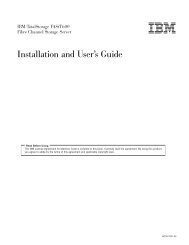Addressing OLTP Solutions with CICS: The Transaction Server ... - Ibm
Addressing OLTP Solutions with CICS: The Transaction Server ... - Ibm
Addressing OLTP Solutions with CICS: The Transaction Server ... - Ibm
Create successful ePaper yourself
Turn your PDF publications into a flip-book with our unique Google optimized e-Paper software.
8.4.5 Graphical User Interface<br />
<strong>The</strong> WLMAppl subscribes to changes in state of managed objects, that is, a <strong>CICS</strong><br />
system or resource, so that it can keep the global cache up to date. When the<br />
WLMAppl is subsequently informed by the SMappl of changes, it updates the<br />
global cache. <strong>The</strong> WLMAppl is also responsible for informing the workload<br />
management cache manager of relevant changes made in the global cache.<br />
Thus the workload management component is kept abreast <strong>with</strong> what is<br />
happening in the real world. For example, if a transaction is no longer active in<br />
a particular <strong>CICS</strong> system, the cache must be updated so that routing decisions<br />
for new pieces of work can take into account the fact that the transaction is no<br />
longer available in that <strong>CICS</strong> system.<br />
8.4.4.2 Workload Management Cache Manager<br />
<strong>The</strong>re is typically one workload management cache manager on each system on<br />
which routing decisions are to be made.<br />
<strong>The</strong> workload management cache manager interfaces <strong>with</strong> the WLMAppl to<br />
transfer data from the global cache to the local cache. It also processes<br />
requests for data from workload management clients. If the requested data is<br />
not available in the local cache, a request is forwarded to the WLMAppl to get<br />
the data from the global cache. If the data is not available in the global cache,<br />
the WLMAppl requests it from the SMappl. <strong>The</strong> workload management cache<br />
manager also informs clients that their requests have been satisfied or that the<br />
requested data could not be found.<br />
8.4.4.3 Workload Management Client<br />
<strong>The</strong>re is one workload management client for each <strong>CICS</strong> component that wants<br />
to determine which is the best <strong>CICS</strong> system to which to route work. <strong>CICS</strong> SM<br />
provides a <strong>CICS</strong> exit for dynamic transaction routing, DPL, <strong>CICS</strong> Client for AIX<br />
ECI work, <strong>CICS</strong> Client for AIX EPI work, and data-dependent routing. For<br />
session-level load balancing, <strong>CICS</strong> SM provides versions of cicsterm and cicsteld<br />
called bhgwterm and bhgwteld, respectively.<br />
<strong>The</strong> workload management client performs the following functions:<br />
• Processes requests from <strong>CICS</strong> clients that want to determine to which <strong>CICS</strong><br />
system to route work<br />
• Searches the local cache for the data to fulfill the workload management<br />
requests from <strong>CICS</strong> clients<br />
• Applies a workload balancing algorithm to determine which of a set of <strong>CICS</strong><br />
systems is best able to do the work for a <strong>CICS</strong> client and then updates the<br />
cache to reflect the decision that it has made<br />
• Requests information from the workload management cache manager when<br />
it cannot be found in the local cache<br />
<strong>The</strong> <strong>CICS</strong> SM GUI is based on a set of windows that have standard elements<br />
common to many GUIs, such as a title bar, maximize and minimize buttons, a<br />
tool bar, and a status line. <strong>The</strong> functions of the GUI are based on a menu<br />
structure that can be accessed through the menu bar items and their pull-down<br />
menus. <strong>CICS</strong> SM has been designed so that it can be operated from the menu<br />
bar only; that is, <strong>with</strong>out the tool or action bars. This is particularly useful for<br />
users <strong>with</strong> limited screen space. Figure 36 on page 118 shows the layout of the<br />
<strong>CICS</strong> SM GUI.<br />
Chapter 8. Using <strong>CICS</strong> System Manager for AIX 117
















